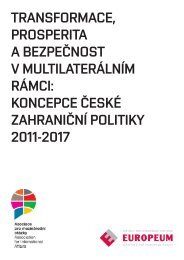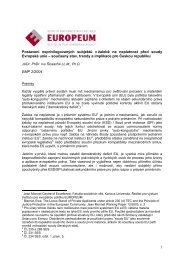eu constitutionalisation - EUROPEUM Institute for European Policy
eu constitutionalisation - EUROPEUM Institute for European Policy
eu constitutionalisation - EUROPEUM Institute for European Policy
You also want an ePaper? Increase the reach of your titles
YUMPU automatically turns print PDFs into web optimized ePapers that Google loves.
Chapter 2: The Convention and IGC Texts of the ConstitutionSUMMARYThe aim of this article is to evaluate the process of the <strong>European</strong> conventionby carrying a retrospective analysis of the changes made by the Inter-Governmental Conference to the text of the constitutional treaty drafted bythe <strong>European</strong> Convention. If the new institutional context and the deliberativesetting of the Convention had a certain lock-in effect on the most powerfulactors (the representatives of the governments) they however regained theirinfluence by pushing national interests to the <strong>for</strong>e because of the need of theIGC approval in the final text. The article will focus on the differences acrossthe issues areas showing that we can find a rather stable consensus in regulativeissues areas of low political salience and high technicality (i.e. simplification ofthe treaties) whereas the major changes operated by the IGC concerned thehigh saliency and redistributive issues areas (i.e. institutional architecture).THE CONVENTION: A “DELIBERATIVEINTERSTICE” BETWEEN LAEKEN AND THE IGCFrom the Nice deadlock to the Laeken mandateThe <strong>European</strong> Union has undergone a continuing process of treaty re<strong>for</strong>maimed at deepening and widening the scope of integration during thelast twenty years. From the Single <strong>European</strong> Act onwards, this evolutionthrough intergovernmental negotiations has followed an incrementallogic and at the same time the progressive enlargements of the EU havepushed <strong>for</strong> a rationalisation of its institutional framework¹. The issues atstake were the redefinition of voting weights in the Council, the size ofthe Commission, a clearer division of competence between the Memberstates and the EU, and the simplification of the treaties.Such a task of rationalisation should have been carried out by the IGC of Nicethat instead failed in proposing efficient solutions and proved the weaknessof the IGC method. As a result the Nice <strong>European</strong> Council in December2000 approved the Declaration on the Future of the <strong>European</strong> Union² in1) DE WITTE (2001).2) Declaration n. 23 on the Future of the Union (annexed to the Treaty of Nice) (2000).Chapter 2: The Convention and IGC Texts of the Constitutionwhich the Member States reaffirmed their commitment to deepen andwiden the debate about the future of the <strong>European</strong> Union. They agreed toconvoke another IGC by 2004 to resolve all these important issues at stakebe<strong>for</strong>e the official joining of the ten new member states; at the same time thegovernments, facing such an outstanding deadlock, decided that an alternativemethod of re<strong>for</strong>m was to be found. The experiment of the Conventionwho drafted the Charter of fundamental rights had proved to be much moreefficient than a normal IGC and it started to be perceived as possible “alternativeavenue” <strong>for</strong> the adoption of the future constitutional re<strong>for</strong>ms.The atmosphere of change was also fostered by the re-emergence ofa constitutional debate that can be traced back to the two speeches of theGerman Foreign Minister Joschka Fischer³ followed by the speeches ofthe Franch President Jacques Chirac⁴, the Italian President Ciampi⁵, andthe Belgian Prime Minister Verhofstadt⁶. The <strong>European</strong> Parliament playedalso a prominent role as it immediately caught the opportunity to rescuethe use of the constitutional language by adopting the Duhamel Report⁷and the subsequent resolution <strong>for</strong> the “constitutionalization of the treaties”.Moreover the idea of <strong>for</strong>mulating a coherent and unique text supported bythe Dahene report⁸ was becoming a real option thanks to a feasibility study⁹of the <strong>European</strong> University <strong>Institute</strong> realized <strong>for</strong> the Commission.During 2001 according to the Nice Declaration wishes, a broad debate wassparkling under the auspices of the Swedish and Belgian presidency.Opening a constitutional debate on the overall structure of the EU insuch large terms was an opportunity <strong>for</strong> the federalists who were trying<strong>for</strong> deeper integration and a more direct democratisation of the EU decision-makingstructure. On the other side, this was also an opportunity <strong>for</strong>the intergovernmentalists to effect a redefinition of the competences of theEU that could have led to a conservative turn in the integration, giving thepace to a re-nationalisation of some competences.¹⁰3) FISCHER (2000).4) CHIRAC (2000).5) CIAMPI (2000).6) VERHOFSTADT (2000).7) DUHAMEL (2000).8) WEIZSÄCKER, DEHAENE and SIMON (1999).9) «Ré<strong>for</strong>mer les procédures de révision des traités – D<strong>eu</strong>xième rapport sur la réorganisation des Traités del’Union Européenne », 31 juillet 2000, (EUI :Florence).10) DE WITTE (2001).52 53








